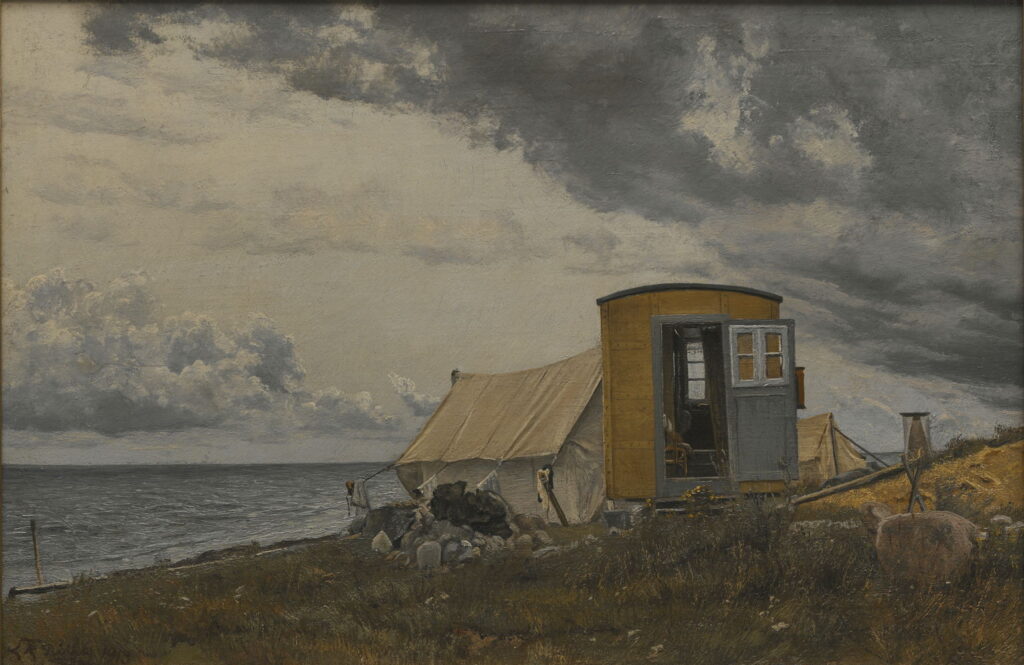Reading visual art: 163 Tents, modern

In the first of these two articles showing tents in paintings, I covered those depicting historical battles of the more distant past. Today’s sequel brings those up to date with tents of the late nineteenth and early twentieth centuries, starting with one of John Singer Sargent’s works as a war artist in the closing months of the First World War.
John Singer Sargent (1856-1925), Interior of a Hospital Tent (1918), watercolour over pencil on paper, 39.4 x 52.7 cm, Imperial War Museums, London. The Athenaeum.
Sargent painted several scenes in military medical facilities, including this watercolour of the Interior of a Hospital Tent, with its packed rows of folding camp beds and a multitude of guy ropes visible through its large windows.
Alberto Pasini (1826–1899), An Arab Camp (1866), oil on wood mounted on wood, 26 x 46 cm, location not known. Wikimedia Commons.
During his travels in the Middle East, Alberto Pasini must have become very familiar with the sight of An Arab Camp, shown here at a small watering place in 1866. From the dress and preponderance of horses, this was probably further north into Syria or even Turkey.
Albert Bierstadt (1830–1902), The Rocky Mountains, Lander’s Peak (1863), oil on canvas, 186.7 x 306.7 cm, Metropolitan Museum of Art, New York, NY. Wikimedia Commons.
Albert Bierstadt’s The Rocky Mountains, Lander’s Peak (1863) was one of his most successful paintings based on the studies from his first visit to the west in 1859. This shows a summit of 3,187 metres (10,456 feet), named by its surveyors after a general who died in the Civil War. The First Nation people shown are Shoshone, seen in their traditional wigwams with their characteristic circular opening.
François-Auguste Biard (1799–1882), The Duke of Orleans Received in a Lapland Camp, August 1795 (1841), oil on canvas, 132 × 163 cm, Château de Versailles, Versailles, France. Wikimedia Commons.
Nearly fifty years after the event, François-Auguste Biard painted The Duke of Orleans Received in a Lapland Camp, August 1795 (1841). This shows the Duke looking disdainful and detached in a Sami tent, apparently shunning the bowl that is being offered to him. The tent’s framework of poles is clearly visible, and put to good use bearing the weight of the pot and drying furs.
Tents were also popular with explorers and those prospecting for valuable minerals such as gold.
Ludwig Becker (1808-1861), Bendigo (1853), watercolour, with pen and ink, pencil and opaque white, 18 x 22 cm, State Library Victoria, Melbourne, Australia. Wikimedia Commons.
Ludwig Becker painted this watercolour view of his prospector’s tent at Bendigo, in the Australian outback during the early years of its gold rush in 1853, one of several paintings he exhibited in Melbourne the following year. At its height, similar tents and shacks housed forty thousand prospectors, including the artist.
Edward Adrian Wilson (1872–1912), Camping after Dark (1910), graphite on paper, further details not known. Wikimedia Commons.
Edward Adrian Wilson’s rough pencil sketch of Camping after Dark (1910) shows a cutaway of a ‘pyramid’ tent in the Antarctic, its three occupants crammed in tightly together. From their tangle of legs and boots to the mittens and balaclava hats hanging to thaw and dry above them, it’s cramped but warm and sheltered. Wilson was one of Captain Scott’s party who died during their return from the South Pole two years later.
Tents had also become popular temporary shelters at fun events across the world.
William Powell Frith (1819–1909), The Derby Day (1856-58), oil on canvas, 140.5 x 264 cm, The Tate Gallery, London. Wikimedia Commons.
William Powell Frith’s famous painting of Derby Day (1856-58) shows some of the canvas palaces installed for this horse-racing festival at Epsom, to the south of London. The tent in the left foreground is that of the Reform Club, an exclusive private members club in London, founded in 1836.
Émile Friant (1863–1932), The Entrance of the Clowns (1881), media and dimensions not known, Private collection. The Athenaeum.
One of Émile Friant’s earliest works is this 1881 painting of The Entrance of the Clowns, showing the interior of the Big Top at the moment that the clowns, acrobats, and other entertainers parade. Many circuses relied on these huge tents to contain their spectators around the ring where the entertainers performed.
Pierre Bonnard (1867-1947), The Beach (Arcachon) (c 1922), oil on canvas, 27.5 x 43.2 cm, Private collection. The Athenaeum.
Pierre Bonnard’s The Beach (Arcachon) from about 1922, shows this beach packed with tents and awnings covering the golden sand, and crowds of people and moored yachts in the distance.
Laurits Andersen Ring (1854–1933), View of a Shore with the Artist’s Wagon and Tent at Enö (1913), oil on canvas, 40 x 61 cm, Nationalmuseum, Stockholm, Sweden. Wikimedia Commons.
In the summer of 1913, the Danish painter Laurits Andersen Ring and his family holidayed in their caravan. In his View of a Shore with the Artist’s Wagon and Tent at Enö, they are seen on the south-west coast of the island of Enø. They have spilled out into a tent, whose heavy guy ropes are being used to dry washing, perhaps not such a far cry from the armies of long past.



